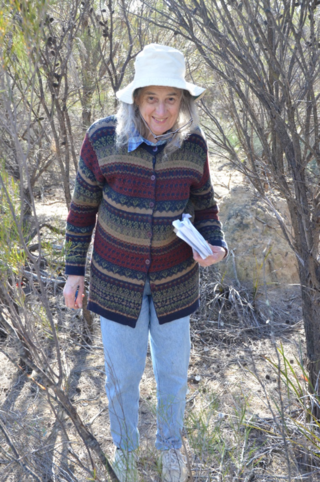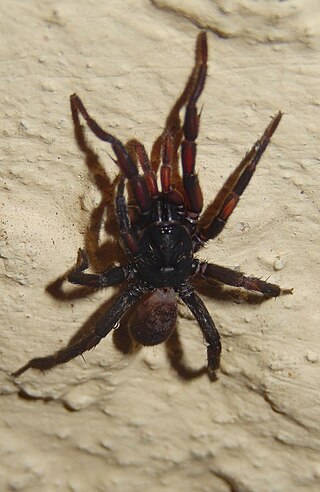
The Mygalomorphae, or mygalomorphs, are an infraorder of spiders, and comprise one of three major groups of living spiders with over 3000 species, found on all continents except Antarctica. Many members are known as trapdoor spiders due to their creation of trapdoors over their burrows. Other prominent groups include Australian funnel web spiders and tarantulas, with the latter accounting for around one third of all mygalomorphs.

The family Dipluridae, known as curtain-web spiders are a group of spiders in the infraorder Mygalomorphae, that have two pairs of booklungs, and chelicerae (fangs) that move up and down in a stabbing motion. A number of genera, including that of the Sydney funnel-web spider (Atrax), used to be classified in this family but have now been moved to Hexathelidae.

Actinopodidae is a family of mygalomorph orb weaver spiders found in mainland Australia and South America usually in open forest. Species are most common in Queensland, Australia. It includes mouse spiders, whose bites, though rare, are considered medically significant and potentially dangerous.

Idiopidae, also known as armored trapdoor spiders, is a family of mygalomorph spiders first described by Eugène Simon in 1889. They have a large body similar to tarantulas.

Migidae, also known as tree trapdoor spiders, is a family of spiders with about 100 species in eleven genera. They are small to large spiders with little to no hair and build burrows with a trapdoor. Some species live in tree fern stems. They have a Gondwanan distribution, found almost exclusively on the Southern Hemisphere, occurring in South America, Africa, Madagascar, Australia, New Zealand and New Caledonia.

Opisthothelae is a suborder of spiders within the order Araneae, containing Mygalomorphae and Araneomorphae, but excluding Mesothelae. The Opisthothelae are sometimes presented as an unranked clade and sometimes as a suborder of Araneae. In the latter case, Mygalomorphae and Araneomorphae are treated as infraorders.

Stanwellia is a genus of South Pacific mygalomorph spiders in the family Pycnothelidae. It was first described by W. J. Rainbow & R. H. Pulleine in 1918. Originally placed with the curtain-web spiders, it was transferred to the funnel-web trapdoor spiders in 1985, then to the Pycnothelidae in 2020. It is a senior synonym of Aparua.

Stanwellia grisea, also known as the Melbourne trapdoor spider, is a species of mygalomorph spider in the Pycnothelidae family. It is endemic to Australia. It was described in 1901 by British arachnologist Henry Roughton Hogg.

Barbara Anne York Main was an Australian arachnologist and adjunct professor at the University of Western Australia. The author of four books and over 90 research papers, Main is recognised for her prolific work in establishing taxonomy for arachnids, personally describing 34 species and seven new genera. The BBC and ABC produced a film about her work, Lady of the Spiders, in 1981.
Number 16, also known as #16, was a wild female trapdoor spider that lived in North Bungulla Reserve near Tammin, Western Australia. She died in 2016, at an estimated age of 43 years, and is the longest-lived spider recorded to date. Number 16 did not die of old age, but was most likely killed by a parasitic wasp sting.

Anamidae is a family of Australian mygalomorph spiders. It was first described as a tribe by Simon in 1889, then raised to the subfamily Anaminae of the family Nemesiidae, before being raised to a family level by Opatova et al. in 2020.
Pycnothelidae is a family of mygalomorph spiders first described in 1917. It was downgraded to a subfamily of the funnel-web trapdoor spiders in 1985, but returned to family status in 2020.
Teyl luculentus, also known as the citrine spider, is a species of mygalomorph spider in the Anamidae family. It is endemic to Australia. It was described in 1975 by Australian arachnologist Barbara York Main, and is the type species of the genus.
Swolnpes darwini is a species of mygalomorph spider in the Anamidae family. It is endemic to Australia. It was described in 2009 by Australian arachnologists Barbara York Main and Volker Framenau.
Stanwellia pexa is a species of mygalomorph spider in the Pycnothelidae family. It is endemic to Australia. It was described in 1930 by Australian arachnologist Vernon Victor Hickman.
Stanwellia nebulosa, also known as the nebular trapdoor spider, is a species of mygalomorph spider in the Pycnothelidae family. It is endemic to Australia. It was described in 1918 by Australian arachnologists William Joseph Rainbow and Robert Henry Pulleine.
Stanwellia inornata is a species of mygalomorph spider in the Pycnothelidae family. It is endemic to Australia. It was described in 1972 by Australian arachnologist Barbara York Main.
Mandjelia platnicki is a species of mygalomorph spider in the Barychelidae family. It is endemic to New Caledonia. It was described in 1994 by Australian arachnologist Robert Raven. The specific epithet platnicki honours Dr Norman I. Platnick, Chairman of the Entomology Department at the American Museum of Natural History, for his contributions to arachnology.
Bungulla bertmaini is a species of mygalomorph spider in the Idiopidae family. It is endemic to Australia. It was described in 2017 by Australian arachnologists Michael Rix, Barbara York Main, Robert Raven and Mark Harvey.







